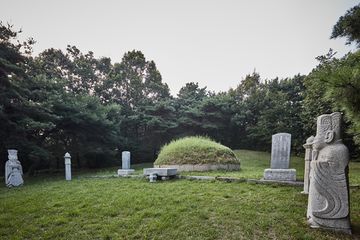"김만기 선생 묘 및 신도비"의 두 판 사이의 차이
(→영문) |
|||
| (다른 사용자 한 명의 중간 판 하나는 보이지 않습니다) | |||
| 1번째 줄: | 1번째 줄: | ||
| − | |||
{{문화유산정보 | {{문화유산정보 | ||
|사진=김만기선생묘및신도비.jpg | |사진=김만기선생묘및신도비.jpg | ||
| 32번째 줄: | 31번째 줄: | ||
These are the tombs of Kim Man-gi (1633-1687), his son Kim Jin-gu (1651-1704), and his grandson Kim Chun-taek (1670-1717), all esteemed civil officials of the Joseon period (1392-1910). | These are the tombs of Kim Man-gi (1633-1687), his son Kim Jin-gu (1651-1704), and his grandson Kim Chun-taek (1670-1717), all esteemed civil officials of the Joseon period (1392-1910). | ||
| − | Kim Man-gi was the great-grandson of the renowned scholar Kim Jang-saeng (1548-1631) and the father of Queen Consort Ingyeong, the wife of King Sukjong (r. 1674-1720). | + | Kim Man-gi was the great-grandson of the renowned scholar Kim Jang-saeng (1548-1631) and the father of Queen Consort Ingyeong, the wife of King Sukjong (r. 1674-1720). Kim Jin-gu served as sixth state councilor, and his son Kim Chun-taek was well-known for his literary skills. |
| − | The tomb of Kim Man-gi, who is buried with his wife Lady Han, is located at the back. Directly in front of this are the tombs of | + | The tomb of Kim Man-gi, who is buried with his wife Lady Han, is located at the back. Directly in front of this are the tombs of Kim Jin-gu and Kim Chun-taek, located to the right and left, respectively. The other tombs belong to their descendants. |
| − | At the very front of the tomb area is a stele erected in 1699 | + | At the very front of the tomb area is a stele erected in 1699 that records the life and achievements of Kim Man-gi. Its inscription was composed by the renowned scholar Song Si-yeol (1607-1689) and calligraphed by Kim Jin-gyu (1658-1716), another son of Kim Man-gi who later became a high ranking civil official. |
| − | + | ===영문 해설 내용=== | |
| − | + | 조선시대의 문신인 김만기(1633-1687)와 아들 김진구(1651-1704), 손자 김춘택(1670-1717)의 묘이다. | |
| − | |||
| − | |||
| − | |||
| − | |||
| − | |||
| − | + | 김만기는 대학자인 김장생(1548-1631)의 증손이며, 숙종(재위 1674-1720)의 왕비인 인경왕후(1661-1680)의 아버지이다. 김진구는 좌참찬을 지냈고, 김춘택은 뛰어난 문장가로 알려졌다. | |
| − | + | ||
| + | 김만기와 부인 한씨의 합장묘는 묘역 제일 상단에 있고, 그 바로 앞에는 김진구와 김춘택의 묘가 있다. 주위에는 다른 후손들의 묘도 있다. | ||
| − | + | 묘역 입구에는 김만기의 생애와 업적을 기록하여 1699년에 세운 신도비가 있다. 비문은 송시열(1607-1689)이 짓고 김만기의 아들인 김진규(1658-1716)이 썼다. | |
| − | 김만기 | + | * 지정된 문화재 명칭은 "김만기 선생 묘 및 신도비"이지만, 이 안내판 문안은 김만기 일가의 묘역을 설명하는 내용임. |
2020년 10월 12일 (월) 20:23 기준 최신판
| 김만기선생묘 및 신도비 Tomb and Stele of Kim Man-gi |
|
 김만기 선생 묘 및 신도비, 국가문화유산포털, 문화재청. |
|
| 대표명칭 | 김만기선생묘 및 신도비 |
|---|---|
| 영문명칭 | Tomb and Stele of Kim Man-gi |
| 한자 | 金萬基先生墓 및 神道碑 |
| 주소 | 경기도 군포시 대야미동 산1-12번지 |
| 지정(등록) 종목 | 경기도 기념물 제131호 |
| 지정(등록)일 | 1992년 6월 5일 |
| 분류 | 유적건조물/무덤/무덤/기타 |
| 수량/면적 | 일원 |
| 웹사이트 | 김만기 선생 묘 및 신도비, 국가문화유산포털, 문화재청. |
|
|
|
해설문
국문
김만기(1633-1687)는 조선 17세기인 효종, 현종, 숙종 연간에 활약한 문신이다. 김만기는 숙종의 장인이 되어 광성부원군에 봉해졌다.
김만기 일가 묘역은 네 개의 구역으로 구분되는데, 상단에는 김만기 부부가 안치되어 있다. 중단 동쪽에는 김만기의 아들 김진구(1651-1704)의 묘, 중단 서쪽에는 김진구의 아들 김춘택(1670~1717)의 묘가 있다. 하단은 김만기 후손의 무덤이 이어져 배치되어 있다.
영문
Tomb and Stele of Kim Man-gi
These are the tombs of Kim Man-gi (1633-1687), his son Kim Jin-gu (1651-1704), and his grandson Kim Chun-taek (1670-1717), all esteemed civil officials of the Joseon period (1392-1910).
Kim Man-gi was the great-grandson of the renowned scholar Kim Jang-saeng (1548-1631) and the father of Queen Consort Ingyeong, the wife of King Sukjong (r. 1674-1720). Kim Jin-gu served as sixth state councilor, and his son Kim Chun-taek was well-known for his literary skills.
The tomb of Kim Man-gi, who is buried with his wife Lady Han, is located at the back. Directly in front of this are the tombs of Kim Jin-gu and Kim Chun-taek, located to the right and left, respectively. The other tombs belong to their descendants.
At the very front of the tomb area is a stele erected in 1699 that records the life and achievements of Kim Man-gi. Its inscription was composed by the renowned scholar Song Si-yeol (1607-1689) and calligraphed by Kim Jin-gyu (1658-1716), another son of Kim Man-gi who later became a high ranking civil official.
영문 해설 내용
조선시대의 문신인 김만기(1633-1687)와 아들 김진구(1651-1704), 손자 김춘택(1670-1717)의 묘이다.
김만기는 대학자인 김장생(1548-1631)의 증손이며, 숙종(재위 1674-1720)의 왕비인 인경왕후(1661-1680)의 아버지이다. 김진구는 좌참찬을 지냈고, 김춘택은 뛰어난 문장가로 알려졌다.
김만기와 부인 한씨의 합장묘는 묘역 제일 상단에 있고, 그 바로 앞에는 김진구와 김춘택의 묘가 있다. 주위에는 다른 후손들의 묘도 있다.
묘역 입구에는 김만기의 생애와 업적을 기록하여 1699년에 세운 신도비가 있다. 비문은 송시열(1607-1689)이 짓고 김만기의 아들인 김진규(1658-1716)이 썼다.
- 지정된 문화재 명칭은 "김만기 선생 묘 및 신도비"이지만, 이 안내판 문안은 김만기 일가의 묘역을 설명하는 내용임.